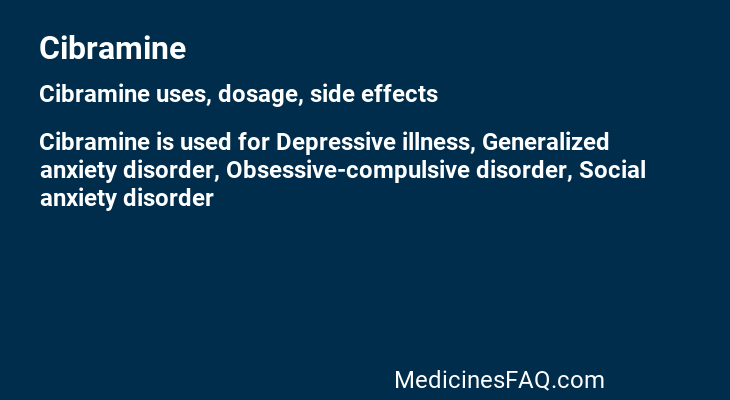Cibramine
Cibramine Uses, Dosage, Side Effects, Food Interaction and all others data.
Cibramine is a selective inhibitor of serotonin (5-HT) re-uptake. The inhibition of 5-HT re-uptake is the only likely mechanism of action explaining the pharmacological and clinical effects of escitalopram. Cibramine has no or low affinity for a number of receptors including 5-HT1A, 5-HT2, DA D1 and D2 receptors, α1-, α2-, β-adrenoceptors, histamine H1, muscarine cholinergic, benzodiazepine and opioid receptors.
Cibramine belongs to a class of medications called selective serotonin re-uptake inhibitors (SSRIs). These agents cause an increase in serotonin levels in neuronal synapses by preventing the re-uptake of serotonin (5-HT) into the presynaptic terminals of serotonergic neurons. As compared to other SSRIs, it appears to have a relatively quick onset of effect due to its potency.
SSRIs as a class have been associated with abnormal bleeding, particularly in patients receiving concomitant therapy with other medications affecting hemostasis, and with the development of serotonin syndrome. Use escitalopram with caution in patients with a higher-than-baseline risk of bleeding and in patients receiving concomitant therapy with other serotonergic drugs. Cibramine may also cause a discontinuation syndrome with abrupt removal of the drug, and should be slowly tapered if discontinuation of therapy is warranted.
| Trade Name | Cibramine |
| Availability | Prescription only |
| Generic | Escitalopram |
| Escitalopram Other Names | (S)-Citalopram, Escitalopram, Escitalopramum |
| Related Drugs | Rexulti, sertraline, trazodone, alprazolam, duloxetine, hydroxyzine, Lexapro, venlafaxine, Zoloft, citalopram |
| Type | |
| Formula | C20H21FN2O |
| Weight | Average: 324.3919 Monoisotopic: 324.163791509 |
| Protein binding | Escitalopram exhibits relatively low protein binding at approximately 55-56%. |
| Groups | Approved |
| Therapeutic Class | SSRIs & related anti-depressant drugs |
| Manufacturer | |
| Available Country | |
| Last Updated: | September 19, 2023 at 7:00 am |

Uses
Cibramine is used for Depressive illness, Generalized anxiety disorder, Obsessive-compulsive disorder, Social anxiety disorder
Cibramine is also used to associated treatment for these conditions: Generalized Anxiety Disorder (GAD), Major Depressive Disorder (MDD), Obsessive Compulsive Disorder (OCD)
How Cibramine works
Cibramine, like other selective serotonin re-uptake inhibitors, enhances serotonergic activity by binding to the orthosteric (i.e. primary) binding site on the serotonin transporter (SERT), the same site to which endogenous 5-HT binds, and thus prevents the re-uptake of serotonin into the presynaptic neuron. Cibramine, along with paroxetine, is also considered an allosteric serotonin re-uptake inhibitor - it binds to a secondary allosteric site on the SERT molecule to more strongly inhibit 5-HT re-uptake. Its combination of orthosteric and allosteric activity on SERT allows for greater extracellular 5-HT levels, a faster onset of action, and greater efficacy as compared to other SSRIs. The sustained elevation of synaptic 5-HT eventually causes desensitization of 5-HT1A auto-receptors, which normally shut down endogenous 5-HT release in the presence of excess 5-HT - this desensitization may be necessary for the full clinical effect of SSRIs and may be responsible for their typically prolonged onset of action.
Cibramine has shown little-to-no binding affinity at a number of other receptors, such as histamine and muscarinic receptors, and minor activity at these off-targets may explain some of its adverse effects.
Dosage
Cibramine dosage
Adults: The initial dose of Cibramine Oxalate is 10 mg once daily. (A fixed dose trial of Cibramine Oxalate demonstrated the effectiveness of both 10 mg and 20 mg of Cibramine Oxalate, but failed to demonstrate a greater benefit of 20 mg over 10 mg.)
If the dose is increased to 20 mg, this should occur after a minimum of one week.
Panic disorder: Adult over 18 years, initially 5 mg once daily increased to 10 mg daily after 7 days; max. 20 mg daily; elderly initially half adult dose, lower maintenance dose may be sufficient;
Social anxiety disorder: Adult over 18 years, initially 10 mg once daily adjusted after 2-4 weeks; usual dose 5-20 mg daily.
Elderly: A single oral dose of 10 mg/day is the recommended dose for most elderly patients. Administered in excess recommended dose has not been yet established.
Side Effects
Cibramine is well tolerated by most people. The most commonly reported side-effects of Cibramine are nausea, insomnia, problems with ejaculation, drowsiness, increased sweating and fatigue. Most of the side-effects experienced by patients taking Cibramine are mild and go away with continued treatment and usually do not cause patients to stop taking Cibramine.
Toxicity
Symptoms of overdose may include CNS effects (dizziness, convulsions, coma, somnolence), gastrointestinal distress (nausea, vomiting), and/or cardiac abnormalities (hypotension, tachycardia, ECG changes). There is no specific antidote for escitalopram overdose. Management of overdose should focus on monitoring for cardiac abnormalities and changes to vital signs as well as treatment with supportive measures as indicated. As escitalopram is highly distributed into tissue following oral administration, forced diuresis, dialysis, and other methods of extracting drug from plasma are unlikely to be beneficial.
Precaution
During marketing of escitalopram and other SSRIs and SNRIs (Serotonin and Norepinephrine Reuptake Inhibitors), there have been spontaneous reports of adverse events occurring upon discontinuation of these drugs, particularly when abrupt, including the following: dysphoric mood, irritability, agitation, dizziness, sensory disturbances (e.g., paresthesias such as electric shock sensations), anxiety, confusion, headache, lethargy, emotional lability, insomnia, and hypomania. While these events are generally self-limiting, there have been reports of serious discontinuation symptoms. Patients should be monitored for these symptoms when discontinuing treatment with escitalopram. A gradual reduction in the dose rather than abrupt cessation is recommended whenever possible. If intolerable symptoms occur following a decrease in the dose or upon discontinuation of treatment, then resuming the previously prescribed dose may be considered. Subsequently, the physician may continue decreasing the dose but at a more gradual rate.
Interaction
Cibramine should not be started until 2 weeks after stopping an MAOI. Conversely, an MAOI should not be started until at least a week after escitalopram or related antidepressant has been stopped.
Food Interaction
- Avoid alcohol. The combined use of alcohol with psychotropic medications should be avoided.
- Take with or without food. The absorption is unaffected by food.
[Moderate] GENERALLY AVOID: Alcohol may potentiate some of the pharmacologic effects of CNS-active agents.
Use in combination may result in additive central nervous system depression and
MANAGEMENT: Patients receiving CNS-active agents should be warned of this interaction and advised to avoid or limit consumption of alcohol.
Ambulatory patients should be counseled to avoid hazardous activities requiring complete mental alertness and motor coordination until they know how these agents affect them, and to notify their physician if they experience excessive or prolonged CNS effects that interfere with their normal activities.
Cibramine Drug Interaction
Moderate: aspirin, aspirin, pregabalin, pregabalin, cetirizine, cetirizineMinor: metoprolol, metoprolol, metoprolol, metoprololUnknown: omega-3 polyunsaturated fatty acids, omega-3 polyunsaturated fatty acids, levothyroxine, levothyroxine, cyanocobalamin, cyanocobalamin, ascorbic acid, ascorbic acid, cholecalciferol, cholecalciferol
Cibramine Disease Interaction
Major: depressionModerate: renal dysfunction, hyponatremia, liver disease, mania, platelet function, seizure disorders, SIADHMinor: weight loss
Volume of Distribution
Cibramine appears to distribute extensively into tissues, with an apparent volume of distribution of approximately 12-26 L/kg.
Elimination Route
Absorption of escitalopram following oral administration is expected to be almost complete, with an estimated absolute bioavailability of approximately 80%. Tmax occurs after about 4-5 hours. Cmax and AUC appear to follow dose proportionality - at steady state, patients receiving 10mg of escitalopram daily had a Cmax of 21 ng/mL and a 24h AUC of approximately 360 ng*h/mL, while patients receiving 30mg daily had a roughly 3-fold increase in both Cmax and 24h AUC, comparatively.
Half Life
The elimination half-life of escitalopram is 27-32 hours, though this is increased by approximately 50% in the elderly and doubled in patients with reduced hepatic function. The elimination half-life of escitalopram's primary metabolite, S-desmethylcitalopram, is approximately 54 hours at steady state.
Clearance
The oral plasma clearance of escitalopram is 600 mL/min, of which approximately 7% is due to renal clearance.
Elimination Route
After oral administration of escitalopram, approximately 8% of the total dose is eliminated in the urine as unchanged escitalopram and 10% is eliminated in the urine as S-desmethylcitalopram. The apparent hepatic clearance of escitalopram amounts to approximately 90% of the total dose.
Pregnancy & Breastfeeding use
Pregnancy: The safety of escitalopram during pregnancy and lactation has not been established. Therefore, escitalopram should not be used during pregnancy unless, in the opinion of the physician, the expected benefits to the patient outweigh the possible hazards to the fetus.
Nursing Mothers: Cibramine is excreted in human milk. Cibramine should not be given to nursing mothers unless, in the opinion of the physician, the expected benefits to the patient outweigh the possible hazards to the child
Contraindication
Concomitant use in patients taking monoamine oxidase inhibitors (MAOIs) is contraindicated. Concomitant use in patients taking pimozide is contraindicated. Esita is contraindicated in patients with a hypersensitivity to escitalopram or citalopram or any of the inactive ingredients.
Special Warning
Pediatric Use: Safety and effectiveness in children below the age of 18 years have not been established.
Geriatric patients: Cibramine pharmocokinetics in subjects age 65 and over were compared to younger subjects in a single and multi-dose study. No overall differences in safety or effectiveness between this group and the younger subjects was observed, but greater sensitivity of some elderly individuals ca
Storage Condition
Store in a cool and dry place below 30º C. Protect from light.
Innovators Monograph
You find simplified version here Cibramine
Cibramine contains Escitalopram see full prescribing information from innovator Cibramine Monograph, Cibramine MSDS, Cibramine FDA label
FAQ
What is Cibramine used for?
Cibramine is mainly used to treat major depressive disorder or generalized anxiety disorder. Cibramine is often used to treat depression and is sometimes used for anxiety, obsessive compulsive disorder or panic attacks.
How safe is Cibramine?
For most people, Cibramine is safe to take for a long time. A few people may get sexual side effects, such as problems getting an erection or a lower sex drive. In some cases these can continue even after stopping the Cibramine.
How does Cibramine work?
Cibramine work by increasing the levels of a mood-enhancing chemical called serotonin in the brain.
What are the common side effects of Cibramine?
Common side effects of Cibramine are include:
Headache, nausea, diarrhea, dry mouth, increased sweating, feeling nervous, restless, fatigue, or having trouble sleeping (insomnia). These will often improve over the first week or two as you continue to take the medication.
Is Cibramine safe during pregnancy?
Cibramine has been linked to a very small increased risk of problems for your unborn baby. But if your depression isn't treated during pregnancy, this can also increase the chance of problems. You may need to take Cibramine during pregnancy if you need it to remain well.
Is Cibramine safe during breastfeeding?
The study shows that Cibramine is safe for use during breastfeeding. Because its absolute infant dose is lower than that for an equivalent antidepressant dose of Cibramine, it may be preferred over Cibramine in treating depression in lactating women.
Can I drink alcohol with Cibramine?
You should avoid or limit the use of alcohol while being treated with Cibramine.
Can I drive after taking Cibramine?
Cibramine might be best to stop driving and cycling for the first few days of treatment until you know how this medicine makes you feel.
When should be taken of Cibramine?
You can take Cibramine at any time of day, as long as you stick to the same time every day. If you have trouble sleeping, it's best to take it in the morning.
Can I take Cibramine on an empty stomach?
You can take it with or without food.
How long does Cibramine take to work?
Cibramine usually takes 4 to 6 weeks for Cibramine to work.
How long can I take Cibramine?
Most people take Cibramine for at least six months after they feel well again. This is to help guard against symptoms returning.
Can Cibramine hurt me?
Cibramine can cause a severe allergic reaction. Symptoms can include: trouble breathing. swelling of your face, tongue, eyes, or mouth.
Who should not take Cibramine?
You should not take Cibramine if you're hypersensitive to Cibramine oxalate, meaning that you have a known allergy to the medication and experience symptoms of allergic reaction, such as difficulty breathing or swelling of the face, mouth, or tongue.
Is Cibramine bad for my memory?
Cibramine had no significant effect on WM accuracy or reaction time. Preliminary analysis of the imaging data revealed no significant differences in memory load dependent activation between conditions.
What happen If I oversose on Cibramine?
Major manifestations of Cibramine overdose were serotonin toxicity, QT prolongation, and bradycardia. The study suggests a potential for cardiac arrhythmias in escitalopram overdose.
What happen If I missed Cibramine?
Missing doses of Cibramine may increase your risk for relapse in your symptoms. Stopping Cibramine abruptly may result in one or more of the following withdrawal symptoms: irritability, nausea, feeling dizzy, vomiting, nightmares, headache, and/or paresthesias.
What happens if I miss one day of my dose?
If you do miss 1 of your doses, skip the missed dose and take your next dose at the usual time. Do not take a double dose to make up for the dose you missed.
Can I take Cibramine at night?
You can take Cibramine at any time of day, as long as you stick to the same time every day. If you have trouble sleeping, it's best to take it in the morning.
Does barnd cause anxiety?
Low levels of Cibramine in the brain may cause depression, anxiety, and sleep trouble.
Can Cibramine affect my heart?
Citalopram and Cibramine, which fall into this drug group, can trigger a heart rhythm disturbance, a new study in the British Medical Journal shows.
Will Cibramine affect my fertility?
Cibramine use in women with a history of anxiety or depression diminishes natural fertility.
Can Cibramine damage my kidneys?
If you taken Cibramine without consultation with your physician, can cause kidney damage.







